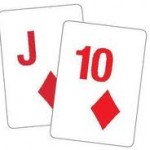 It’s commonly accepted knowledge that the true value of suited connectors comes when you’re in multi-way hands. The reason being is that suited connectors are capable of taking down huge pots when they hit, but you need several other players to be in the hand to make them pay off. But before you run off taking this knowledge with you, there are a few things to consider before always using suited connectors in multi-way pots.
It’s commonly accepted knowledge that the true value of suited connectors comes when you’re in multi-way hands. The reason being is that suited connectors are capable of taking down huge pots when they hit, but you need several other players to be in the hand to make them pay off. But before you run off taking this knowledge with you, there are a few things to consider before always using suited connectors in multi-way pots.
The first thing is that suited connectors are almost always going to be drawing hands on the flop. This being the case, a hand with several other players often sees at least one person hit something on the flop. When this happens, they are going to make drawing hands pay big to stay in the hand. So not only have you paid to see the flop, but now you’re going to have to keep paying to see more cards.
Besides the fact that you often have to pay for a chance at making a hand with suited connectors, another problem arises with middle and small suited connectors. These hands are extremely vulnerable since they have little value besides eventually turning into straights or flushes. Even if you do make your straight or flush, there’s also the chance that a player with better suited connectors has you beat. So it’s rarely a good idea to play 6-7 or lower; you even have to be cautious with 7-8 to 10-J because there’s no big overcard here to provide additional value.
Now don’t take all of this as a rant against suited connectors. However, you do need to be careful when playing them, and mainly stick to playing connectors in position with big overcards. You can also play them when you’re looking to bluff another player.